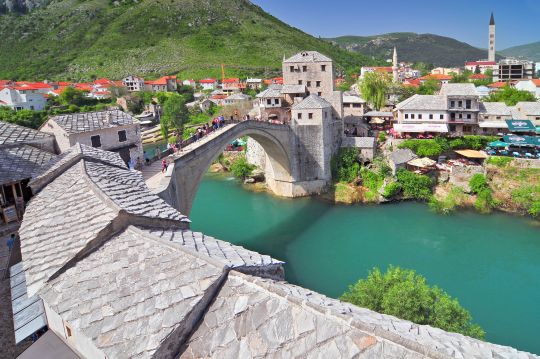|
Mostar |
 Mostar derives its name from the bridge keepers, mostari, that watched over its historic bridge, Stari Most (Old Bridge). The Stari Most over the Neretva River, has been a symbol of both the unity and the divisions in this multiethnic city, ever since it was built in 1566. On one side of the Naretva is the old Turkish quarter, Kujundiluk. It is made up of a maze of narrow cobbled streets lining both sides of the emerald Neretva River, and its a haven of small shops, cafes and artists' studios, where artisans hammer intricate designs into copper plates, jugs and coffee pots. The are still active mosques and most houses are built around the Turkish style courtyards with pebbles laid out in intricate designs and fountains that refer to important aspects of Muslim life. The other side of the Naretva is the Catholic part of the town with many restaurant and cafe terraces overlooking the river. The atmosphere is that of a constant movement with people talking animatedly, eating civipcici and drinking coffee. Bosnian coffee has its own ritual. It is sucked slowly through a lump of sugar held in the teeth, followed by a sip of water and finished with a gooey lump of Turkish delight.
|
 Tragically, the Old Bridge of Mostar was destroyed by the Croatian Army in June of 1992, but it has since been rebuilt using stone from the same quarry as the original bridge. After the war, Croatia donated money to a monumental project to rebuild the bridge. Even though "Stari Most" stands again, the city remains divided along its ethnic lines. Scanning the skyline, one quickly recognizes the competition between the rising minarets on one side of the river and the grandiose Catholic Church bell tower on the other side. Almost every building has shot or mortar marks in it, and ruined buildings litter the city. However, visiting Mostar is not only a sobering experience, but also an uplifting one. There are local men jumping from the top of the bridge into the shallow water below, which they will do only when they have collected a certain amount of money from the tourists. |





